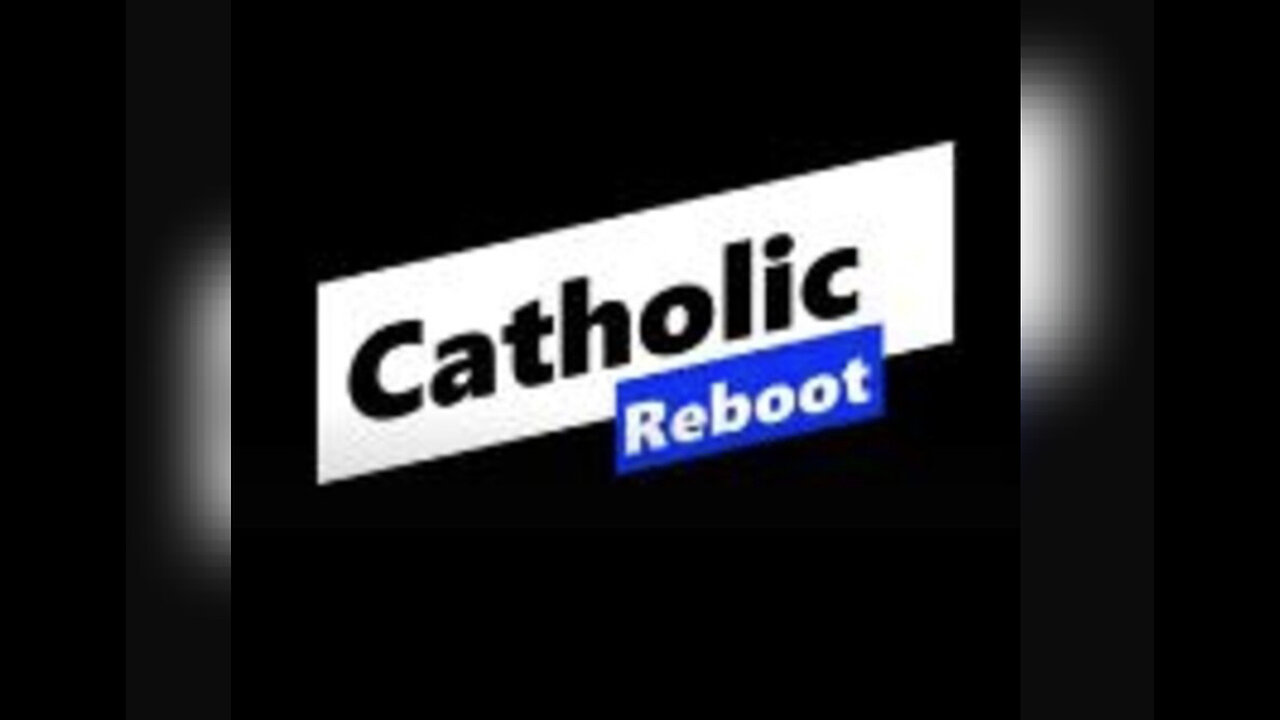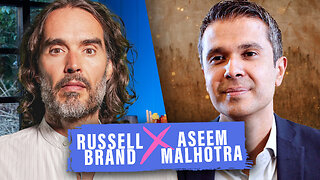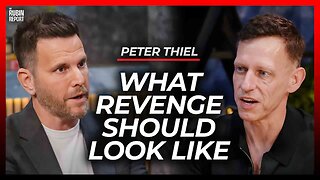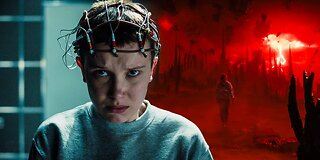Premium Only Content

Episode 2679: What are the 4 No's? - Part 1 of 2
Remember the blessed mothers warning in 1917 before there was even a communist party. She warned that if people did not turn back to God and amend their ways, Russia would spread its errors throughout the world, causing wars, persecutions, and suffering for the Church and the faithful.
This prophecy highlighted concerns about atheistic ideologies, the oppression of religious freedom, and the social and moral harms associated with communist regimes. Our Lady urged the faithful to pray the Rosary daily and to make acts of reparation for sinners, promising that through these actions and the consecration of Russia, her Immaculate Heart would eventually triumph.
Did you ever hear about the 4 no’s? Its starting to regain its popularity with the young people but I wonder if they truly know where it came from. I am a firm believer that those who do not know their history ignorantly repeat it.
The new movement among young women that came out of Korea is called The 4B movement gained its name due to the 4 rules beginning with a ‘B’ sound when spoken in Korean. No sex with men (bisekseu), no child-rearing (bichulsan), no dating men (biyeonae), and no marriage with men (bihon). It gained traction in 2019, being a feminist movement against the nation’s rigid rules applied to women that also came to affect the way those who aren’t women view them. The movement is believed to have begun at the perfect time as the government is pushing incentives in an attempt to raise their birth rate, though none of these incentives are designed to support women anymore, merely encouraging them to quickly get with someone and have more children.
But this is just a retread of a previous communistic movement that was called the "Four No's" 1. “No God, 2. No Religion, 3. No Family, 4. No Private Property” are indeed visible in modern society, especially among younger generations. These trends are influenced by secular and ideological shifts and reflect a movement away from traditional values. Here’s a closer look at how each of these "No's" is manifesting:
1. No God
Rise of Secularism and “Spiritual but Not Religious” Attitudes: Many young people today identify as “spiritual but not religious” or simply “agnostic,” reflecting a growing indifference toward organized religion. Belief in God and absolute moral truths is often replaced by a subjective sense of spirituality or an emphasis on self-reliance.
Focus on Self and Individualism: Messages of “finding your truth” or “manifesting your reality” encourage self-centered spirituality, subtly pushing the notion that God is irrelevant to personal happiness and fulfillment. This approach can minimize God’s role, making Him secondary or even unnecessary.
2. No Religion
Religious Relativism and Interfaith Blurring: There’s a trend among young people toward religious relativism, where all religions are seen as fundamentally the same. This perspective often leads to the conclusion that no single faith is truly “right” or necessary, diluting religious identity and commitment.
Decline in Formal Religious Practice: Formal religious attendance and affiliation are at historic lows among younger generations, with many choosing secular lifestyles and prioritizing moral values like tolerance and inclusivity over doctrinal faith. This undermines the structure of religion and shifts focus toward broader social issues.
3. No Family
Redefinition of Family Structures: Traditional concepts of family as a union between a man and a woman with children are increasingly viewed as outdated or restrictive. There is strong cultural acceptance of non-traditional family structures, which can diminish the idea of family as a foundational, natural institution.
Prioritizing Individualism Over Family Roles: Many young people delay or choose not to marry, opting to focus on personal achievements, career goals, and lifestyles that avoid commitment. As a result, family formation rates are declining, and the sense of duty to future generations and the concept of family as the “domestic church” become less emphasized.
4. No Private Property
Growing Popularity of Economic Collectivism: Younger generations tend to favor socialist or collectivist economic models that emphasize wealth redistribution, free access to goods and services, and government control over resources. These ideas can overshadow traditional rights to private property, which have been part of Catholic social teaching for centuries.
“Sharing Economy” and Minimalist Lifestyles: Trends like minimalism and the sharing economy (e.g., communal living spaces, car-sharing, etc.) encourage young people to value experience over ownership. While some of these trends offer positive environmental benefits, they can also lead to a devaluation of personal property rights as a positive good.
The Broader Societal Impact
These trends among the younger generation reflect a broader cultural shift toward secular humanism and collectivist ideals. The influence of media, education, and certain political ideologies often promotes these views, framing them as progressive and inclusive. While young people are often motivated by genuine concerns for social justice and equality, the uncritical adoption of secular, collectivist values can lead them away from traditional family structures, religious identity, and personal responsibility, which are foundational to Catholic teaching.
So let me tell you where it came from.
The “Four No’s” doctrine in China during the 1960s refers to a set of ideological principles promoted by the Chinese Communist Party (CCP) during the early stages of the Cultural Revolution (1966-1976). This doctrine was a key part of the effort to root out perceived capitalist, traditional, and bourgeois influences that the Party considered harmful to the communist revolution.
The “Four No’s” were:
1. No new ideas: This was an attempt to suppress any form of dissent or alternative thinking that could undermine the Party’s authority. It emphasized the importance of maintaining strict ideological conformity to Marxist-Leninist thought and the teachings of Chairman Mao Zedong.
2. No new politics: The aim here was to prevent the introduction of non-communist political structures or reforms. The leadership wanted to ensure the CCP remained the central political force in China, discouraging any political movements that might threaten its monopoly on power.
3. No new people: This was a means of enforcing loyalty to the Party by discouraging new leadership or “outsiders.” It was part of an effort to maintain control over all sectors of society and prevent new leaders from emerging who might challenge the existing hierarchy.
4. No new culture: The cultural revolution sought to eliminate traditional Chinese cultural elements that were deemed “feudal” or “reactionary,” including Confucian values, and replace them with a culture that conformed to socialist ideals. This was achieved through a campaign of destruction of cultural symbols, such as temples, books, and historical artifacts.
The “Four No’s” played a significant role in the cultural upheaval of the time. They were part of the broader ideological crackdown that sought to consolidate power within the CCP, eradicate “counter-revolutionary” elements, and promote Maoist thought, which reached its peak during the Cultural Revolution. This was a period marked by political purges, mass mobilizations, and widespread violence as individuals and groups were attacked for perceived ideological failings.
Now let’s look at how the modern Catholic Church’s trajectory under certain guidance might be seen as paralleling the “four no’s” of the Communist Party’s agenda from the 1960s revolution, from a traditional Catholic perspective.
The Modern Church and the “Four No’s”: A Traditional Catholic Examination
So lets review the communistic 4 No’s first.
1. No God
2. No Religion
3. No Family
4. No Private Property
Section 1: The First “No”-“No God”
In communist ideology, the concept of “No God” promoted a society without religious devotion, where secular ideology could become the unifying belief system. This agenda saw any organized worship or religious allegiance as a threat to the state’s authority, aiming to create a secular, godless society.
Parallels in the Church Today:
In recent decades, some traditional Catholics perceive a shift within the Church toward what seems like a softening of the distinct, Christ-centered nature of Catholicism. This shift, they feel, reflects elements of secular humanism, where the focus appears to be more on human unity and “universal brotherhood” than on a call to repentance and devotion to God.
Emphasis on Human Dignity over Divine Sovereignty
In many Church statements today, there is an overwhelming emphasis on human dignity, freedom, and equality, sometimes without clear reference to God as the ultimate source of these values. While human dignity is indeed central to Catholic teaching, traditional Catholics worry that by focusing predominantly on secular language around “human rights” and “equality,” the Church is aligning with a worldly view rather than reminding people of their inherent worth as creatures made in God’s image.
Example: Many modern homilies, statements, and even some Church documents prioritize messages of inclusivity and tolerance while often omitting strong calls to conversion or specific references to the necessity of Jesus Christ as Savior. This emphasis, while well-intentioned, can sometimes blur the distinction between Catholic belief and secular humanitarianism, which upholds human dignity without recognizing God’s sovereign role.
Universal Brotherhood without the Fatherhood of God
Recent language in the Church has frequently emphasized universal brotherhood, promoting unity among people of all faiths and beliefs. However, traditional Catholics worry that this emphasis on “fraternity” might lead to an ambiguous view of religious identity, where the uniqueness of the Catholic faith is downplayed in favor of a message of inclusivity.
Example: Interfaith events and statements about all religions leading to God can sometimes seem to promote the idea that all faiths are equally valid. In traditional Catholic teaching, while interfaith dialogue is important, it should ultimately be oriented toward revealing Christ as the fullness of truth. Statements that appear to elevate the "brotherhood of man" without reference to God as the true Father can leave Catholics feeling that their faith is being presented as one option among many.
Promotion of a Secularized “Social Gospel”
In recent years, some Church leaders have focused heavily on social issues like climate change, economic inequality, and immigration, addressing them primarily through the lens of secular language rather than explicitly Catholic teachings. Traditional Catholics argue that by adopting secular approaches to these issues, the Church risks appearing like a humanitarian organization rather than a divine institution concerned primarily with salvation.
Example: Many Catholics are concerned when statements on these issues lack direct references to God, Jesus, or Church teachings. This absence, some argue, seems to present the Church as a mere advocate for social change, distancing itself from its role as a guide to spiritual truth. This trend can lead to a perception that the Church is replacing its mission of spreading the Gospel with a secular mission to “improve the world.”
Diminished Role of Christ as the Exclusive Path to Salvation
One of the most central concerns for traditional Catholics is the growing sense that Christ’s unique role as the Savior of humanity is being downplayed. The traditional teaching that “outside the Church, there is no salvation” has been softened in many modern statements, replaced with language suggesting that all people, regardless of faith, are on equal footing.
Example: In some interfaith dialogues and papal statements, traditional Catholics notice a tendency to speak of all religions as valid paths, diminishing the call for conversion to Christianity. This is seen as a departure from the Church’s mission to evangelize and spread the truth of Christ’s saving power.
Why This Matters:
For traditional Catholics, these trends signal a departure from the Church’s historic mission to proclaim Christ as the only way to God. By promoting universal values without specifically upholding God’s sovereignty, the Church, they argue, risks losing its unique voice in a secular world. Without clarity that the Church exists to lead people to Christ, the faithful may be left with a vague moral framework that reflects secular humanism rather than Catholic truth.
A Call to Return to Tradition:
To address these concerns, traditional Catholics call for a return to a Christ-centered message, one that clearly articulates God’s sovereignty, the unique role of Jesus as Savior, and the Catholic Church as the true path to eternal life. This involves reviving teachings that affirm God’s rightful place above all human efforts, reminding the world that true unity and fraternity can only be achieved through acknowledging God’s love and authority.
In this view, Catholics are reminded that their primary mission is not just to improve the world socially but to prepare souls for eternal life with God, a mission that requires clarity about God’s place as Lord and Creator of all.
Section 2: The Second “No”-“No Religion”
In the communist worldview, “No Religion” meant the elimination of organized faith, viewing religion as an obstacle to secular progress and unity. By removing religion from public life, communist regimes aimed to create a society where state ideology would reign supreme without the “disruptive” influence of faith or moral convictions tied to a higher power.
From a traditional Catholic perspective, certain trends within the Church appear to echo this principle, where a diminished emphasis on Catholic doctrine, identity, and sacramental reverence leaves the faithful vulnerable to a secular worldview that devalues religious life altogether.
1. Dilution of Catholic Identity
The Church has long promoted ecumenism, especially since the Second Vatican Council, with a sincere goal of fostering dialogue and understanding among various Christian denominations and other religions. However, some traditional Catholics argue that in emphasizing interfaith unity, the Church has inadvertently weakened her own distinct identity.
Blurring of Doctrinal Boundaries: Traditional Catholics see a rise in ambiguity regarding the necessity of Catholic doctrine and sacraments for salvation. Increasingly, statements on interfaith unity have suggested that salvation is accessible outside the Church, leading many Catholics to question whether their faith is uniquely true or simply one of many valid belief systems.
Example: Events and statements that emphasize the equality of all faiths, without affirming the Catholic Church as the true Church founded by Christ, risk promoting religious relativism. This can foster the perception that Catholic doctrine is flexible and that commitment to Catholic teachings is optional.
Decline in Conversion Efforts: Traditional Catholics also notice a decline in the Church’s emphasis on conversion to the Catholic faith, which has historically been central to her mission. By prioritizing dialogue over evangelization, the Church risks losing sight of her role to bring others to Christ and to the truth of the Catholic faith.
Example: Some interfaith initiatives are conducted without a call to conversion, a stark contrast to the Church’s historical mandate to “make disciples of all nations.” This trend can contribute to a diminished sense of the importance of Catholicism itself, where Catholics may feel their faith is no longer the exclusive means to salvation.
2. Fruits of Modernist Reforms
Many traditional Catholics believe that certain reforms instituted since Vatican II have unintentionally contributed to a decline in Catholic identity and reverence, leading to what some might consider a practical atheism or a world “without religion.”
Loss of Sacramental Reverence: Since Vatican II, the Church has seen widespread changes in the liturgy and sacramental practices, which some believe have contributed to a casual attitude toward the sacraments. Traditional Catholics argue that changes such as receiving Communion in the hand and simplified liturgical practices have led to a loss of reverence for the Eucharist, the source and summit of Catholic life.
Example: With a less formal and more casual approach to liturgy, many Catholics may feel less awe and reverence for the sacraments. This shift reflects a movement away from traditional expressions of faith, potentially leading the faithful to view sacraments as symbols rather than sacred realities that convey grace.
Decline in Vocations and Catechesis: Traditional Catholics also observe a sharp decline in priestly and religious vocations, attributing this to a lack of doctrinal formation and spiritual depth in the post-Vatican II Church. The trend toward “modernizing” Church teachings and practices has, in their view, resulted in a generation with weak catechesis, lacking a deep understanding of Catholic doctrine and moral teachings.
Example: In many parishes, the focus on social justice or community-building has overshadowed formal catechesis. This weak formation echoes a world where religion is viewed as an option rather than a necessary foundation for life, aligning with the communist idea of a society without strong religious influence.
Rise of Cafeteria Catholicism: Many Catholics today feel free to choose which doctrines to follow, which traditional Catholics see as a sign of weakened identity. This phenomenon reflects a loss of respect for the authority of the Magisterium and a growing indifference to moral teachings, leaving the faithful with a diluted sense of what it means to be Catholic.
Example: Issues such as contraception, abortion, and marriage are often treated as matters of personal choice rather than moral obligations, reflecting a secular attitude where religious rules are seen as arbitrary.
3. Contrast with Traditional Perspectives
Traditional Catholic teaching emphasizes that salvation is found exclusively through Christ and that the sacraments are vital channels of grace for the faithful. From this perspective, the Church’s mission is clear: to lead souls to Christ and to uphold the integrity of Catholic doctrine. A strong Catholic identity is essential, rooted in the belief that the fullness of truth resides uniquely within the Church founded by Jesus.
Salvation through Christ Alone: Traditional Catholic teaching stresses that salvation comes through Christ, the only Redeemer. Catholics have a responsibility to share the truth of the Gospel and the importance of the Church as the true path to God. This belief doesn’t diminish respect for other religions but affirms Catholicism as the fullness of truth.
Example: The saints, popes, and martyrs upheld that the Church is necessary for salvation and that unity with Christ means union with His Church. For them, “No Religion” is counter to Christ’s mandate to make disciples of all nations.
Essential Role of the Sacraments: Traditional Catholicism holds that the sacraments are vital to a life of grace. Each sacrament was instituted by Christ to sanctify the faithful, making the Mass and Eucharist central to Catholic identity. Traditional practices such as Communion on the tongue or reverent silence during Mass emphasize the sacredness of these mysteries, fostering a sense of awe and devotion.
Example: Many traditional Catholics argue that the reverence of the Traditional Latin Mass and practices around the sacraments foster a deeper understanding of God’s presence, helping Catholics live their faith authentically.
Catholic Doctrine as Non-Negotiable: Traditional Catholics emphasize that the Church’s teachings on faith and morals are not optional. Doctrines are divinely revealed truths, not mere suggestions. From this view, the Church should proclaim these truths boldly and clearly, without compromise or ambiguity, to protect the faithful from a world that often questions or contradicts them.
Example: By emphasizing clarity and certainty in Catholic teaching, traditionalists see the Church’s role as guiding souls to heaven, not merely as promoting ethical values or social good. A “No Religion” approach abandons this mission, leaving Catholics without a clear sense of moral and spiritual direction.
Conclusion: The Importance of a Strong Catholic Identity
From this perspective, the trend toward secularized language, ecumenism, and “modernization” within the Church is troubling because it risks diluting the faith. For traditional Catholics, a weakened Catholic identity is not only a betrayal of the Church’s mission but also a pathway to a world without the richness of religious truth and moral guidance. Instead, they call for a return to the Church’s historical mission of evangelization, formation, and reverence offering the world not “No Religion,” but the fullness of the Catholic faith as the true path to salvation.
This section highlights the dangers of a secularized Church and calls for the faithful to uphold and cherish the distinct identity of the Catholic faith in a world increasingly indifferent to religious truth.
-
 31:39
31:39
Peter Santenello
1 year agoStories From Vegas' Golden Era 🇺🇸
61.6K25 -
 LIVE
LIVE
The Why Files
12 hours agoLIVE: The Why Files 24/7 Stream n' Chat
1,310 watching -
 55:15
55:15
Russell Brand
1 day agoThe Truth About Big Pharma & COVID with Dr. Aseem Malhotra
174K11 -
 1:19:48
1:19:48
The Rubin Report
12 hours agoWhat the Trump Administration Must Do Instead of Revenge | Peter Thiel
131K168 -
 1:59:00
1:59:00
Steve-O's Wild Ride! Podcast
3 days ago $36.87 earnedPatrick Bet-David DESTROYS Steve-O's Dad - Wild Ride #252
150K52 -
![[XboxONE] GRINDING 1000g FC24](https://1a-1791.com/video/fwe1/01/s8/1/y/k/I/o/ykIoy.0kob-small-XboxONE-GRINDING-1000g-FC24.jpg) 3:29:15
3:29:15
deathbee
15 hours ago[XboxONE] GRINDING 1000g FC24
101K10 -
 1:08:32
1:08:32
Winston Marshall
1 day agoThe HIDDEN Agenda: Congresswoman Hageman UNCOVERS USAID Fraud, Censorship and Human Trafficking
128K144 -
 8:16
8:16
CarlCrusher
1 day agoThe True Story of Stranger Things and the Montauk Project Origins
78K26 -
 10:05
10:05
ariellescarcella
1 day agoNo, You're Not Having A 'Gender Crisis' You're Just Bored
79.6K62 -
 41:08
41:08
The Finance Hub
1 day ago $19.86 earnedBREAKING: DONALD TRUMP JR. SHOCKS THE WORLD!
70.4K119